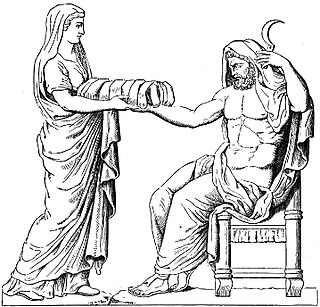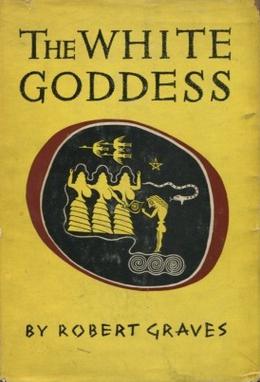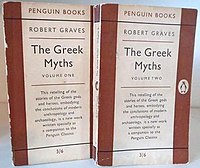
Captain Robert von Ranke Graves was an English poet, soldier, historical novelist and critic. His father was Alfred Perceval Graves, a celebrated Irish poet and figure in the Gaelic revival; they were both Celticists and students of Irish mythology.

Rhea or Rheia is a mother goddess in ancient Greek religion and mythology, the Titan daughter of the earth goddess Gaia and the sky god Uranus, himself a son of Gaia. She is the older sister of Cronus, who was also her consort, and the mother of the five eldest Olympian gods and Hades, king of the underworld.
Eurynomê is a name that refers to the following characters in Greek mythology:

In ancient Greek religion and Greek mythology, Minthe is an Underworld Naiad nymph associated with the river Cocytus. She was beloved by Hades, the King of the Underworld, and became his mistress. But she was transformed into a mint plant by either his wife Persephone or her mother Demeter. The plant was also called by some as hedyosmos, which means "sweet-smelling".
In some versions of Greek mythology, Ophion, also called Ophioneus (Ὀφιονεύς) ruled the world with Eurynome before the two of them were cast down by Cronus and Rhea.

The name Pelasgians was used by Classical Greek writers to refer either to the predecessors of the Greeks, or to all the inhabitants of Greece before the emergence of the Greeks. In general, "Pelasgian" has come to mean more broadly all the indigenous inhabitants of the Aegean Sea region and their cultures, and British historian Peter Green comments on it as "a hold-all term for any ancient, primitive and presumably indigenous people in the Greek world".

The White Goddess: a Historical Grammar of Poetic Myth is a book-length essay on the nature of poetic myth-making by the English writer Robert Graves. First published in 1948, the book is based on earlier articles published in Wales magazine; corrected, revised and enlarged editions appeared in 1948, 1952 and 1961. The White Goddess represents an approach to the study of mythology from a decidedly creative and idiosyncratic perspective. Graves proposes the existence of a European deity, the "White Goddess of Birth, Love and Death", much similar to the Mother Goddess, inspired and represented by the phases of the Moon, who lies behind the faces of the diverse goddesses of various European and pagan mythologies.

The cosmic egg, world egg or mundane egg is a mythological motif found in the cosmogonies of many cultures that is present in Proto-Indo-European culture and other cultures and civilizations. Typically, the world egg is a beginning of some sort, and the universe or some primordial being comes into existence by "hatching" from the egg, sometimes lain on the primordial waters of the Earth. Typically, the upper half of the egg, or its outer shell, becomes the heaven (firmament) and the lower half, or the inner yolk, becomes the Earth. The motif likely stems from simple elements of an egg, including its ability to offer nourishment and give rise to new life, as is reflected by the Latin proverb omne vivum ex ovo.
The Triple Goddess is a deity or deity archetype revered in many Neopagan religious and spiritual traditions. In common Neopagan usage, the Triple Goddess is viewed as a triunity of three distinct aspects or figures united in one being. These three figures are often described as the Maiden, the Mother, and the Crone, each of which symbolizes both a separate stage in the female life cycle and a phase of the Moon, and often rules one of the realms of heavens, earth, and underworld. In various forms of Wicca, her masculine consort is the Horned God.
Euhemerism is an approach to the interpretation of mythology in which mythological accounts are presumed to have originated from real historical events or personages. Euhemerism supposes that historical accounts become myths as they are exaggerated in the retelling, accumulating elaborations and alterations that reflect cultural mores. It was named for the Greek mythographer Euhemerus, who lived in the late 4th century BC. In the more recent literature of myth, such as Bulfinch's Mythology, euhemerism is termed the "historical theory" of mythology.

Pherecydes of Syros was an Ancient Greek mythographer and proto-philosopher from the island of Syros. Little is known about his life and death. Some ancient testimonies counted Pherecydes among the Seven Sages of Greece, although he is generally believed to have lived in the generation after them. Others claim he may have been a teacher of Pythagoras, a student of Pittacus, or a well-traveled autodidact who had studied secret Phoenician books.
In Greek mythology, Hegemone was a Greek goddess of plants, specifically making them bloom and bear fruit. According to Pausanias, Hegemone was a name given by the Athenians to one of the Graces. Auxo represented the spring, and Hegemone autumn.

The Dictionary of Greek and Roman Biography and Mythology is a biographical dictionary of classical antiquity, edited by William Smith and originally published in London by Taylor, Walton and John Murray from 1844 to 1849 in three volumes of more than 3,700 pages. It is a classic work of 19th-century lexicography. The work is a companion to Smith's Dictionary of Greek and Roman Antiquities and Dictionary of Greek and Roman Geography.
In Roman and Greek mythology, Carpus is a minor character associated with fertility and springtime. Similarly, Karpo, one of the Horae, is the feminine equivalent of Karpos; her dominion being the fruits of the earth.
Eurynome was a deity of ancient Greek religion worshipped at a sanctuary near the confluence of rivers called the Neda and the Lymax in classical Peloponnesus. She was represented by a statue of what we would call a mermaid. Tradition, as reported by the Greek traveller, Pausanias, identified her with the Oceanid, or "daughter of Ocean", of Greek poetry.

Two Minoan snake goddess figurines were excavated in 1903 in the Minoan palace at Knossos in the Greek island of Crete. The decades-long excavation programme led by the English archaeologist Arthur Evans greatly expanded knowledge and awareness of the Bronze Age Minoan civilization, but Evans has subsequently been criticised for overstatements and excessively speculative ideas, both in terms of his "restoration" of specific objects, including the most famous of these figures, and the ideas about the Minoans he drew from the archaeology. The figures are now on display at the Heraklion Archaeological Museum (AMH).

A matriarchal religion is a religion that emphasizes a goddess or multiple goddesses as central figures of worship and spiritual authority. The term is most often used to refer to theories of prehistoric matriarchal religions that were proposed by scholars such as Johann Jakob Bachofen, Jane Ellen Harrison, and Marija Gimbutas, and later popularized by second-wave feminism. These scholars speculated that early human societies may have been organized around female deities and matrilineal social structures. In the 20th century, a movement to revive these practices resulted in the Goddess movement.

In Ancient Greek religion and mythology, Cronus, Cronos, or Kronos was the leader and youngest of the first generation of Titans, the divine descendants of the primordial Gaia and Uranus. He overthrew his father and ruled during the mythological Golden Age, until he was overthrown by his own son Zeus and imprisoned in Tartarus. According to Plato, however, the deities Phorcys, Cronus, and Rhea were the eldest children of Oceanus and Tethys.

In Greek mythology, Gaia, also spelled Gaea, is the personification of Earth. Gaia is the ancestral mother—sometimes parthenogenic—of all life. She is the mother of Uranus (Sky), from whose sexual union she bore the Titans, the Cyclopes, and the Giants; as well as of Pontus (Sea), from whose union she bore the primordial sea gods. Her equivalent in the Roman pantheon was Terra.












